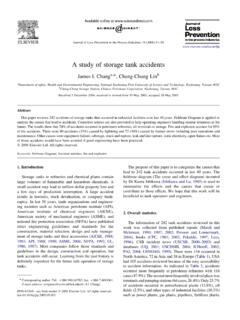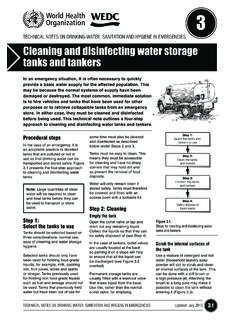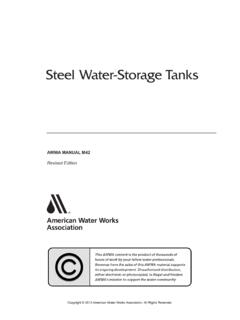Transcription of EVAPORATION LOSS MEASUREMENT FROM STORAGE …
1 EVAPORATION LOSS MEASUREMENT FROM STORAGE tanks Class # Eric Stricklin Program Engineer Greenhouse Gas Chesapeake Operating, Inc. 6100 N. Western Ave. Oklahoma City, OK, USA INTRODUCTION EVAPORATION from fixed and floating roof STORAGE tanks is a major source of product loss in the crude oil industry. EVAPORATION is a natural phenomenon describing when a liquid turns into a gas. A liquid will tend to evaporate depending on its vapor pressure. A liquid s vapor pressure is dependent on the surface temperature and composition of the liquid . EVAPORATION losses should be minimized to help maximize company revenue, meet regulatory requirements, and reduce greenhouse gas emissions.
2 The United States Environmental Protection Agency (EPA), state, and local governments are implementing stricter regulations on volatile organic compounds (VOC s) and greenhouse gas (GHG) emissions which result from STORAGE tank EVAPORATION . The accurate quantification of evaporative losses from STORAGE tanks is imperative given the impact to the company s bottom line and the environment. The American Petroleum Institute Manual of Petroleum MEASUREMENT Standards (API MPMS) Chapter 19 details equations for estimating the average annual EVAPORATION loss from STORAGE tanks . These equations are based on test tank and field tank data and have been revised since initial publication for more accurate estimations.
3 WHAT IS EVAPORATION ? EVAPORATION is when a substance changes from the liquid phase to the vapor phase (at conditions that do not result in boiling). EVAPORATION occurs when molecules in the liquid substance have enough kinetic energy to overcome the intermolecular forces in the liquid phase. The tendency for a substance to evaporate is dependent on the liquid s volatility and temperature. Volatility is a material property that describes how readily a liquid enters the gaseous phase. The volatility of a liquid is quantified by its vapor pressure. The vapor pressure of a substance is the pressure of its gaseous phase when it is in equilibrium with its liquid phase. The higher the vapor pressure of a liquid the more volatile the liquid and thus has a higher tendency to evaporate.
4 Different liquids have different vapor pressures at the same temperature, but all liquids become more volatile with increasing temperature. The higher the liquid s temperature, the higher the average kinetic energy of the molecules in the liquid , increasing the vapor pressure and resulting in a greater rate of EVAPORATION . EVAPORATION FROM CRUDE OIL AND CONDENSATE Crude oil and condensate are multi-component liquids made up of a wide range of hydrocarbons that have different volatilities. In addition, the composition of crude oil and condensate will be different for each well. Therefore, evaluating the evaporative losses from crude oil and condensate is challenging because the composition of the liquid mixture must be known and no two STORAGE tanks carry the same liquid mixture.
5 Crude oil and condensates are typically classified by their density, which is measured by API gravity. Crude oil and condensate with a low density (high API gravity) typically consist of smaller hydrocarbons and have higher vapor pressures, and hence are more volatile. High API gravity crude oil or condensate is primarily composed of hydrocarbons with fewer carbon atoms than C20. Heavy crude oil has a low API gravity and low vapor pressure, and hence is less volatile. Heavy crude oils are primarily composed of C40+ hydrocarbons. For any crude oil or condensate mixture its composition determines its API gravity, which in turn is a good indicator of its volatility or tendency to evaporate. The EVAPORATION rate of crude oil and condensate is logarithmic over time because the more volatile components evaporate first at high rates followed by the less volatile components.
6 The lighter molecules evaporate first leaving the heavier molecules behind causing a reduction in the rate of EVAPORATION with time, typical of a logarithmic trend. EVAPORATION IN STORAGE tanks EVAPORATION in crude oil and condensate STORAGE tanks leads to lost saleable product, air pollution, and greenhouse gas emissions. STORAGE tanks store produced crude oil and condensate at near-atmospheric pressure. Produced gas or oil from the wellhead typically passes through at least a separator and sometimes a heater-treater depending on the quality of the gas/oil. The separated liquids from the separator and heater-treater are dumped to STORAGE tanks . Once the liquids have settled in the STORAGE tank, gases from EVAPORATION are contained in the tank until the pressure in the tank exceeds the set point on the tank Evaporative losses occur primarily in two ways: standing losses and working losses.
7 The total evaporative loss from any STORAGE tank is the sum of the standing losses, LS, and the working losses, LW. LT (pounds per year) = LS + LW Standing losses result from the thermal expansion and contraction of the tank and vapor mixture from the daily heating cycle. As the temperature increases during the day, the air-vapor mixture expands and increases the pressure in the tank. If the pressure in tank exceeds the set points on the tank vents, vapor is vented from the tank resulting in evaporative losses. Standing losses occurs without any change in liquid level in the tank. The standing losses are a function of the following: Tank shell height Tank diameter Roof outage - volume contained under a cone roof or dome roof liquid height liquid surface temperature Vapor pressure Vent settings Working losses result from the change in liquid level in the tank.
8 When the liquid level increases, the vapor in the tank is compressed increasing the pressure in the tank. If the pressure in the tank exceeds the set point on the tank vents, vapor is vented from the tank resulting in evaporative losses. Working losses are a function of the following: Stock turnover rate Annual throughput Tank diameter liquid height liquid surface temperature Vent settings Vapor density Vapor pressure There are several types of STORAGE tanks . Two common STORAGE tank types for crude oil and condensate are fixed roof tanks and floating roof tanks . Established methodologies for quantifying evaporative losses from each STORAGE tank type are described below.
9 1 Tank vents are generally mounted on the tank roof and protect the tank from overpressure or over vacuum. When pressure in the tank vapor space inside the tank exceeds the pressure set point, the pressure-vacuum vent opens to release the vapors until the pressure is reduced below this set point. If a vacuum is formed in the tank, the vent opens to allow air to enter the tank until the vacuum is reduced below the set point. Fixed Roof A fixed roof tank is an enclosed tank with a roof, but does not have a lid floating directly on the liquid surface. Vapors accumulate in the space between the tank roof and the liquid surface. Figure 1 shows a diagram of a typical fixed roof STORAGE tank.
10 Figure 1. Typical Fixed Roof Tank The equations below assume the following (for instances where the assumptions below are not valid refer to API MPMS ): Vertical tanks liquid with a true vapor pressure less than or equal to psia (equivalent to 70 API gravity crude) The standing losses from a fixed roof STORAGE tank can be estimated using the equation below. For more information on the dimensionless factors used in the equation below refer to the API MPMS Chapter =365 4 where, LS = total standing losses (lb/yr) KE = vapor space expansion factor (dimensionless) HVO = height of vapor space between tank roof and liquid surface (ft) D = tank diameter (ft) Ks = vented vapor saturation factor (dimensionless) WV = stock vapor density (lb/ft3) The working losses from a fixed roof STORAGE tank can be estimated using the equation below.








